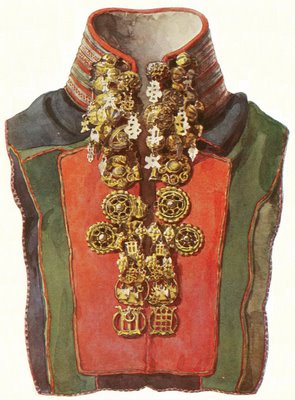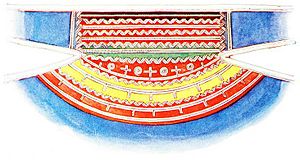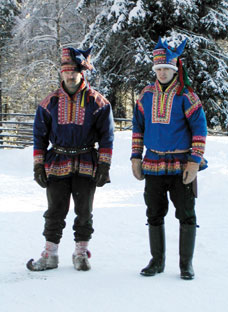Gákti facts for kids


The Gákti is a special traditional clothing worn by the Sámi people. They live in northern parts of countries like Norway, Sweden, Finland, and Russia. Sámi people wear the gákti for important events and even for daily work, especially when they are herding reindeer.
This unique outfit often has a main color with bright bands of other colors. It can also feature braids, shiny pewter embroidery, and a tall collar. In Norway, it's called a 'kofte', and in Sweden, it's known as a 'kolt'.
Contents
What the Gákti Tells Us
The colors, patterns, and decorations on a gákti can tell you a lot. For example, they can show if a person is married or where they come from. There are different gáktis for women and men. Men's gáktis are usually shorter than women's.
Long ago, gáktis were made from reindeer skin. Today, people often use wool, cotton, or silk instead. People wear the gákti with a special belt. This belt might have pleats, quilting, or silver buttons. They also add silver jewelry, traditional leather shoes, and a silk scarf.
The buttons on the belt can also share information. If the buttons are square, it means the person is married. If they are round, the person is not married.
Gákti Names in Different Sámi Languages
"Gákti" is the name for this clothing in the Northern Sámi language. Other Sámi languages have their own names for it:
- South Sámi: gaeptie/gapta/gåptoe
- Ume Sámi: gápttie
- Pite Sámi: gáppte, gåppto
- Lule Sámi: gáppte/gábdde
- Inari Sámi: mááccuh
- Skolt Sámi: määccaǩ
- Kildin Sámi: ма̄цэх/юххьп/юппа
About Fake Gákti Outfits
Sometimes, in places like Lappland, you might see people dressed in outfits that look like gáktis but are not real ones. These are often used by the tourist industry. People who are not Sámi might wear these fake outfits and perform "traditional rituals."
The real Sámi people are very upset about this. It creates a wrong idea of what Sámi culture is truly like. It also means that money from tourists goes to people who are not Sámi, instead of helping the Sámi community. It's important for tourists to know the difference and support real Sámi culture.
See also
 In Spanish: Gákti para niños
In Spanish: Gákti para niños


